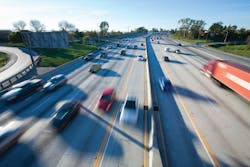"Nitrogen in tires?" says one anonymous automotive instructor incredulously. "The air already is 78 percent nitrogen. Shop air is just as good."
That is the feeling among many vehicle owners and maintainers.
The use of high-concentration nitrogen gas in tires has been around for years, notably in racing (IndyCar, Formula 1 and Nascar), aircraft tires (commercial and military) and by vehicles used by NASA. However, even though this technology is hardly new, it still arouses the suspicion of many in the automotive maintenance business.
Even technical experts who do not specialize in tires, or chemistry for that matter, just do not seem able to get their heads around the idea that nitrogen inflation poses many benefits exceeding that of old-fashioned shop air.
The logic is simple enough. Regular air already inflates a tire, so how can a different kind of air make any difference?
A simple understanding of chemistry answers this question. Just as a little bit of salt can melt ice, oxygen and water vapor can drastically change the properties of inert nitrogen gas.
So, what does that have to do with tires?
ENEMY NUMBER 1: OXIDATION
Anyone who has ever changed a tire can attest to the fact that it is important to clean the rim because the rust that forms can create air leaks after the replacement tire is installed.
First, the steel and aluminum oxides that are rust poses a health hazard to technicians unlucky enough to breath it in by mistake when breaking a tire bead. Furthermore, water vapor and oxygen in the shop air makes the rust in a rim increase until the point where it bubbles up and allows a path for air to escape.
Air escaping from a tire not only hurts fuel economy, it also creates premature tire wear. An underinflated tire poses not only a safety hazard to a fleet, it affects a business' bottom line.
Additional dangers and consequences of improper tire inflation include reduced vehicle handling, tire failures and decreased stopping distances.
"Oxidation, more commonly known as rust, rot and corrosion, is the absolute enemy of anything composed of rubber or steel, (such as) the tires and wheels on your vehicle," says Jay Lighter, CEO of NitroFill (nitrofill.com), a provider of leading nitrogen gas inflation equipment. "Without the presence of oxygen (in pure nitrogen gas), it is impossible for oxidation to occur."
Another lesser known effect of oxidation is that according to laboratory research, oxygen works its way into the rubber molecules in the tire. The reason this is a big deal is that when oxygen reacts with rubber it changes its chemical properties making it morre susceptible to wear.
Granted, there's oxygen in the atmosphere contacting the tire's tread at all times, but it isn't being pushed into the rubber at 32 psi, 24/7.
ENEMY NUMBER 2: LOW TIRE PRESSURE
The negative effects of low tire pressure are obvious. All new light duty vehicles beginning with the 2008 model year come with Tire Pressure Monitoring Systems (TPMS). The systems which continuously monitor the inflation pressure in tires through sensors. This can help fleets keep their tires properly inflated.
It would be an error to assume that TPMS can solve any fleet's tire inflation issues. A tire can often be 5 or more psi low on air without triggering a dashboard indicator light, simply because TPMS often measure the deviation in psi between tires. This means a light will not go on when a tire is 10 percent low on air, provided that all the other tires are equally low.
Furthermore, TPMS do not help if drivers do not warn their supervisors when the "idiot light" (driver lingo for the TPMS Malfunction Indicator Light) is on.
"The greatest disadvantage of oxygen, however, is its molecular size," points out Lighter. "Oxygen has a very small molecular structure, so small in fact that it is completely normal for air-filled tires to lose 1 to 3 psi per month from 'permeation,' the process through which the oxygen molecules in compressed air seep through the carcass of a tire.
"Nitrogen, on the other hand, has a very large molecular structure. A molecule of nitrogen is about four times larger than a molecule of oxygen. Hence, tires filled with high-purity nitrogen typically lose no pressure over a one-month period."
A MATTER OF SCIENCE
Everyone from large tire chains to local tire shops sell nitrogen inflated tires. Oftentimes, they make use of exaggerated claims as to the effects of using nitrogen. So, what's fact and what's hype?
A study by Nader Jalili and Prakash Venkataraman of Clemson University (www.clemson.edu), deriving its results from laboratory testing, found that fuel economy gains, minus real road conditions, could be as high as 23 percent. They also estimated that due to decreased oxidation, tread wear can be reduced as much as 50 percent.
Other studies that actually depended upon using sets of tires on the open highway have corroborated the results. Lawrence R. Sperberg of the Probe Forensic and Testing Laboratory observed that in a test of 54 truck tires subjected to real-world driving conditions tread wear was reduced 26 percent.
A more telling study was one undertaken by Konrad Mech of Drexan Corporation. That study followed the lives of almost 1,300 tires, all with identical maintenance, in order to ensure that the tires stayed properly inflated at all times.
Because of careful attention paid to proper tire inflation (probably more careful than that practiced by an average fleet), the study found a 3.3 percent improvement in fuel economy in tires that used nitrogen gas. Perhaps more astonishingly, the study found an 86 percent increase in tread life in the same tires.
With varying different numbers as it pertains to an exact improvement in fuel economy and tread life, it is important to keep in mind that tire size and driving conditions can affect results. However, science does bare out that the results are positive, showing real promise for long-term cost savings when using nitrogen gas in tires.
TOOLING UP FOR NITROGEN INFLATION
Inflating tires with nitrogen is a pretty straightforward process. Using a nitrogen tire inflation machine, simply connect the shop air hose to the machine and use the machine's hose on the shop's tire applications. This includes not only adding air to tires during maintenance and tire replacement, but using it to fill the air tank in the shop's bead blaster.
Nitrogen inflation equipment generally operates at about 10 percent less than the shop's air compressor's rated capacity. So, being that most shops have an air compressor of about 150 psi, the equipment will generate something along the lines of 135 psi of pure nitrogen gas on demand. As long as the shop's air compressor keeps running, a nitrogen inflation machine will not run out of nitrogen and will continue to generate nitrogen gas.
Furthermore, these pieces of equipment often come with several hoses allowing shops to fill as many as six tires at once.
If a shop converts over to nitrogen, and due to an on-road breakdown or other circumstance finds it has to fill a tire with regular air, there is no need to fear. Studies have found that from a practical standpoint a tire that is filled with 96 percent nitrogen is just as good as one filled completely with nitrogen.
If a tire is filled fully with regular air, there is also no problem posed by simply removing the valve core and then refilling the tire completely with nitrogen. Tires can go between 99 percent nitrogen air and 78 percent nitrogen air with no problems.
For this reason, nitrogen inflation equipment often will purge a tire of regular air, fill it with nitrogen and then purge it again before refilling it. All the equipment is doing is creating a high enough concentration of nitrogen gas that oxidation is essentially non-existent.
When considering switching over to and maintaining tires with nitrogen air, a best practice is for a fleet to estimate the costs for tooling up for nitrogen inflation and see how long it would take to make the money back as the result of decreased tire costs and fuel savings.

